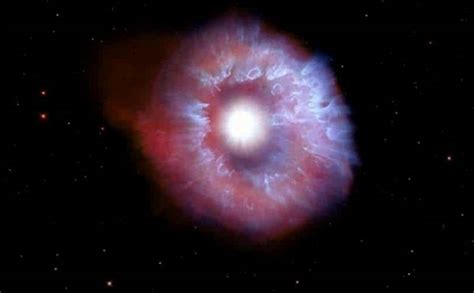
Bu görüntü, büyük bir yıldızın – Vela süpernova kalıntısının – patlayıcı ölümünden sonra geriye kalanları oluşturan turuncu ve pembe bulutların muhteşem bir görüntüsünü göstermektedir. Bu ayrıntılı görüntü 554 milyon pikselden oluşmaktadır ve ESO’nun Paranal Gözlemevi’nde barındırılan VLT Tarama Teleskobu’ndaki 268 milyon piksellik OmegaCAM kamera ile alınan gözlemlerin birleştirilmiş mozaik görüntüsüdür. OmegaCAM, her biri teleskopun yayılan ışığı farklı bir renkte görmesini sağlayan birkaç filtre aracılığıyla görüntü alabilir. Bu görüntüyü yakalamak için, burada macenta, mavi, yeşil ve kırmızı kombinasyonu ile temsil edilen dört filtre kullanılmıştır. Sonuç, hem kalıntıdaki gazlı iplikçiklerin hem de görüntüye ışıltı katan ön plandaki parlak mavi yıldızların son derece ayrıntılı ve çarpıcı bir görüntüsüdür. Kredi: ESO/VPHAS+ ekibi, Teşekkür: Cambridge Astronomik Araştırma Birimi
Vela süpernova kalıntısının bu karmaşık görüntüsünde ne görüyorsunuz? Ürkütücü bir örümcek ağı, büyülü ejderhalar veya hayaletlerin incecik izleri?
Bu güzel renk halısı, kozmik bir felaketten sonra devasa bir yıldızın hayalet kalıntılarını gösteriyor. Avrupa Güney Gözlemevi’nde (Avrupa Güney Gözlemevi) barındırılan VLT Tarama Teleskobu ile burada dikkate değer ayrıntılarla yakalandı.[{” attribute=””>ESO
All that remains of a massive star that ended its life in a powerful explosion around 11,000 years ago is this wispy structure of pink and orange clouds. When massive stars reach the end of their life, they often go out with a bang, in an outburst called a supernova. These massive cosmic explosions cause shock waves that move through the surrounding gas, compressing it and creating intricate thread-like structures. The energy released heats the gaseous tendrils, making them shine brightly, as seen in this image.

Dive into the details of the Vela supernova remnant with these 12 highlights, each showing a different intricate part of the beautiful pink and orange gaseous clouds and the bright stars in the foreground and background. Credit: ESO/VPHAS+ team, Acknowledgment: Cambridge Astronomical Survey Unit
In this 554-million-pixel image, we get an extremely detailed view of the Vela supernova remnant, named after the southern constellation Vela (The Sails). You could fit nine full Moons in this entire image, and the whole cloud is even larger. This dramatic supernova remnant is one of the closest known to us, at a distance of only 800 light-years away from Earth. As it exploded, the outermost layers of the progenitor star were ejected into the surrounding gas, producing the spectacular filaments that we observe here. What remains of the star is an ultra-dense ball in which the protons and electrons are forced together into neutrons — a neutron star. The neutron star in the Vela remnant, placed slightly outside of this image to the upper left, happens to be a pulsar that spins on its own axis at an astonishing speed of more than 10 times per second. This image shows the process of going from the raw data captured by a telescope to a stunning astronomical image like the one featured here, showing the Vela supernova remnant as seen with the VLT Survey Telescope (VST). Credit: ESO/M Kornmesser, VPHAS+ team, Acknowledgment: Cambridge Astronomical Survey Unit
This image is a mosaic of observations taken with the wide-field camera OmegaCAM at the VLT Survey Telescope (VST), hosted at ESO’s Paranal Observatory in Chile. The 268-million-pixel camera can take images through several filters that let through light of different colors. In this particular image of the Vela remnant, four different filters were used, represented here by a combination of magenta, blue, green, and red.
VST, İtalya’daki Ulusal Astrofizik Enstitüsü INAF’a aittir ve 2,6 metrelik aynasıyla gece gökyüzünü görünür ışıkta araştırmaya adanmış en büyük teleskoplardan biridir. Bu görüntü, böyle bir anketten bir örnektir: Güney Galaktik Düzlem ve Çıkıntının VST Fotometrik Ha Araştırması (VPHAS+). Yedi yıldan fazla bir süredir, bu araştırma, gökbilimcilerin yıldızların nasıl oluştuğunu, geliştiğini ve sonunda nasıl öldüğünü daha iyi anlamalarına olanak tanıyarak, ana galaksimizin önemli bir bölümünü haritaladı.

Bu videoda, ESO’nun Şili’deki Paranal Gözlemevi’nde barındırılan VST teleskopunda OmegaCAM ile yakalanan güzel ve dramatik Vela süpernova kalıntısının son derece ayrıntılı görüntüsünde uçacağız. Görüntü, 11.000 yıl önce devasa bir yıldızın patlamasından kaynaklanan şok dalgaları tarafından oluşturulan sayısız yıldız ve ince gaz liflerini açığa çıkaran 554 milyon pikselden oluşuyor. Kredi: ESO/VPHAS+ ekibi, Teşekkür: Cambridge Astronomik Araştırma Birimi